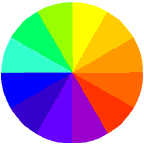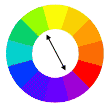Choosing Colors
Color is a very important element to the candle maker. Color grabs our eyes, alters our mood, beautifies our surroundings, and evokes feelings of days long past. Although there are volumes and volumes of written material based on the topic of color, this article will just highlight on a few key aspects that impact the candle maker directly. For our purposes in the candle making community, color may quite simply be boiled down to the sensation caused by light rays as they interact with the human eye, brain, and past experience. Here are a few tips that help candlemakers control color and use it as a tool to help create wonderful candles that tempt the eye and tease the senses.
The Basics

primary and secondary colors
For some of us, it has been a while since we sat through an art class. If the following paragraph is too dry or basic, please continue on to the next paragraph about the actual techniques that are used in candle making. The three primary colors are red, blue, and yellow. These 3 colors are mixed to create all the other colors in the rainbow. When you mix the 3 primary colors, you get the secondary colors, green orange and purple. From there on out you can mix any color you need. This is how a color wheel was developed. When using multiple colors in a single candle, a good starting point is to use analogous or complementary colors. Analogous colors are those that are next to each other on the color wheel such as shades of yellow and green. Complementary colors are those that are opposite on the color wheel. These are just the basic starting point to a phenomenon that knows no boundaries. You can use colors that resemble groupings found in nature, school/team colors, the latest popular interior design colors, or anything else that touches you or your customers’ inner feelings.

complementary colors
There are countless techniques available to candle makers to help solve color challenges. The first question a candle maker must ask themselves is how important is uniformity. Uniform color may be extremely important to larger manufacturers as well as any candle maker looking to sell their candles wholesale to stores that will be reselling the candles. The uniformity is important for aesthetics on the shelf in a retail environment. Increasing batch sizes solves this challenge. The larger the batch, the easier it is to measure dye accurately. This is simply achieved by using a larger melt tank. The sound of a larger tank might sound painful on the budget, but sometimes it may be necessary for some investment in equipment if the candle maker is looking to produce candles that are “factory perfect”. If you are using color blocks, it never hurts to buy larger amounts of dye per order to insure colors from the same lots. This saves money on shipping expenses, material cost, and helps to insure you have enough dye on hand to handle any order that comes through your door – especially during the busy season.
Quality measuring tools are very important when measuring color. Whether you are using a scale, a dropper, or a measuring cup, it is important that you use the precise amount each time. It helps to have a heat resistant white surface to put a few drops of color on to visually see if they match the last drops but remember the drops will not accurately represent the true color.Believe it or not, there are times when color uniformity is not as important as it seems. Take for instance online purchases. All monitors and printers interpret color slightly differently, so the color of the finished candle will probably never match the screen of the purchaser. Slight variation may be OK. If you are marketing the fact your candles are hand poured, there are times when customers expect slight differences in color and actually appreciate the choice between shades. In the case of fundraisers or direct sales, the purchaser is usually helping to support the seller and has a bit of tolerance for slight variations in color. It is up to the candle maker to make the choice and tailor their operations to fir customer expectations.
EVO line of liquid dye is known to candle makers for its consistency, deep color, and user-friendly attributes. Candle makers who market vegetable waxes appreciate the fact that EVO dyes are made using eco-friendly ingredients and do not have a bad odor. Our color blocks are an easy way to use color with less mess and our large selection eliminates the need to manually mix colors (but you may mix them if you prefer). Pigment dyes produce spectacularly deep colors, but are used for over dips only (if you use pigment to color the core, it may clog the wick). Powder dyes are the most economical way to color large batches. They are extremely strong, and although they may be economical, care should be used because a little goes a very long way. Please remember that your color may fade after all your hard work, so a little insurance is to use UV light absorbers U.V. 531 and U.V. 5411 to help maintain the color you want.
